"He put a plastic bag over my head and started suffocating me." On the International Day against Torture, we speak about torture in Belarus
Today is the International Day in Support of Victims of Torture. On this day, on April 26 in 1987, the Convention Against Torture and Other Cruel, Inhuman, or Degrading Treatment or Punishment came into effect. After the mass protest actions in 2020, those who disagree with the actions of the authorities have been actively tortured in Belarus for four years now. In detention, they are subjected to severe systematic beatings. They are placed in crowded cells where the lights are always on. Prisoners are forced to stand in uncomfortable and exhausting poses for a long time during inspections. A new type of torture is incommunicado, i. e. complete isolation from the outside world. And at least six political prisoners died behind bars due to poor conditions of detention and untimely medical care.
Together with the Torture Documentation Department and DIGNITY - Danish Institute against Torture, we talk about examples of torture and ill-treatment of political prisoners in Belarus. We do not aim to list all the cases in this article, but only tell you about some of them. Almost every prisoner who has survived incarceration in a pre-trial detention centre or colony says that they have experienced some kind of ill-treatment. So we understand that due to information isolation, many cases may remain unknown.
Types of torture
"The officer said he would open my skull." Beating
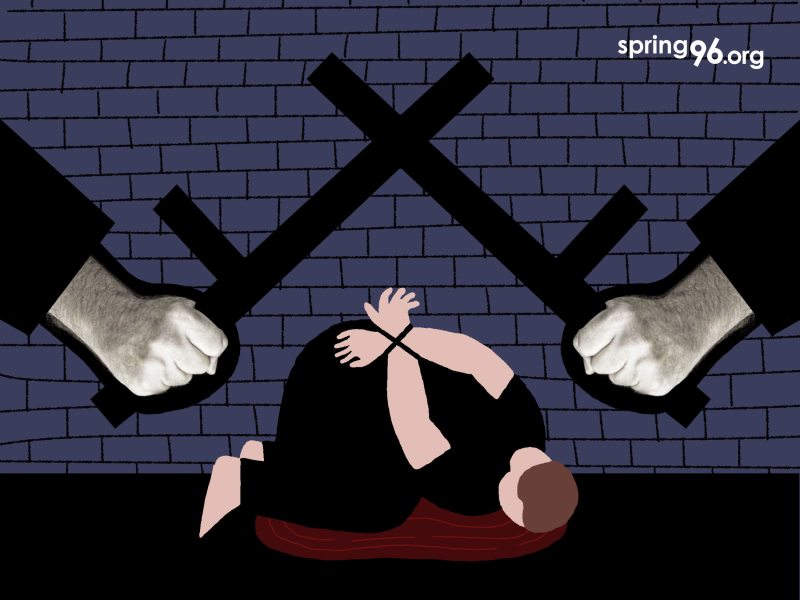
- Illustration by spring96.org
Beating is a form of corporal punishment that, under certain circumstances, is torture. The consequences of beatings are quite extensive. Bruises are the most common type of injury after a beating.
This, in August 2020, in the first few days of the protests, mass detentions and repressions took place. Belarusians, as well as citizens of other countries, were brutally beaten in pre-trial detention centres, police stations, investigative committees, and even on public transport. The protesters were beaten until they lost consciousness.
Dzmitry Khadarovich, whose car was shot at by security forces during his arrest in August 2020 and who was severely beaten, spoke to Viasna.
"Then they started beating me up severely. Two men were holding my hands, and the third was hitting me in the face. I had braces back then. The riot policeman beat so hard that in some places the braces pierced my lips and went through them. When I was drinking, water was pouring out.
Then they turned me over and started hitting me hard on the back of my head. At that moment, the security officer took out some kind of iron weapon and either jokingly or seriously said he would open my skull. I had a concussion."
The systematic beating of prisoners in Belarusian places of detention continues today.
"I'll suffocate and it will end." Asphyxia
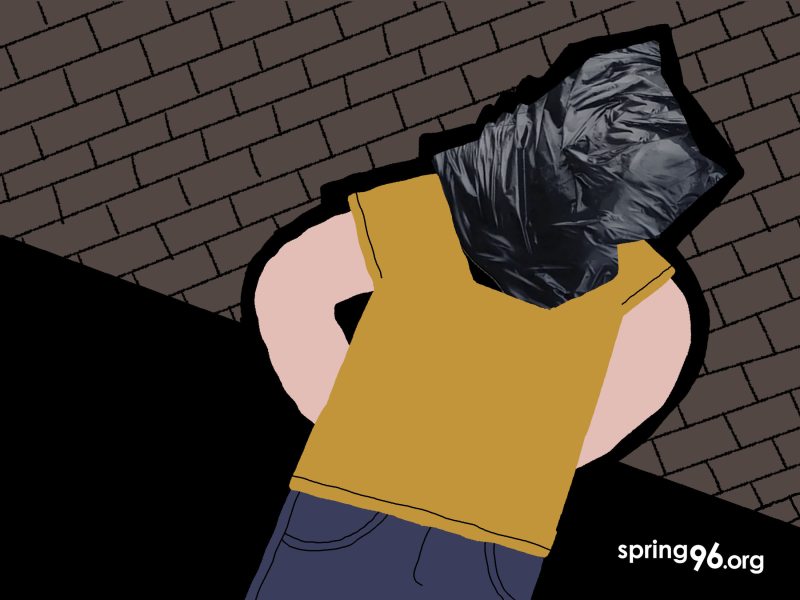
- Illustration by spring96.org
Suffocation (or asphyxia) can be dry, wet, and positional. According to research by the DIGNITY Institute, dry asphyxia is the most common. It is a compression of the neck to block the respiratory tract, or forced inhalation of dust, gas, etc. Asphyxia falls under the definition of torture according to the UN Convention against Torture.
This is how one of the prisoners described the suffocation by the security forces officers (the interlocutor asked not to be named).
"One of the officers held my head between his knees, put a plastic bag on it, which he took out of the closet, and began to suffocate me. I was thinking, let it be over already. I'll suffocate and it will end," the interlocutor said.
According to human rights defenders, Women’s Colony No. 24 staff in Zarečča have subjected Viktoryia Kulsha to psychological and physical pressure. It is reported that one of the guards applied a rare choke on her and dragged her around the cell.
"They ordered me to spread my legs one and a half meters wide." Stress position
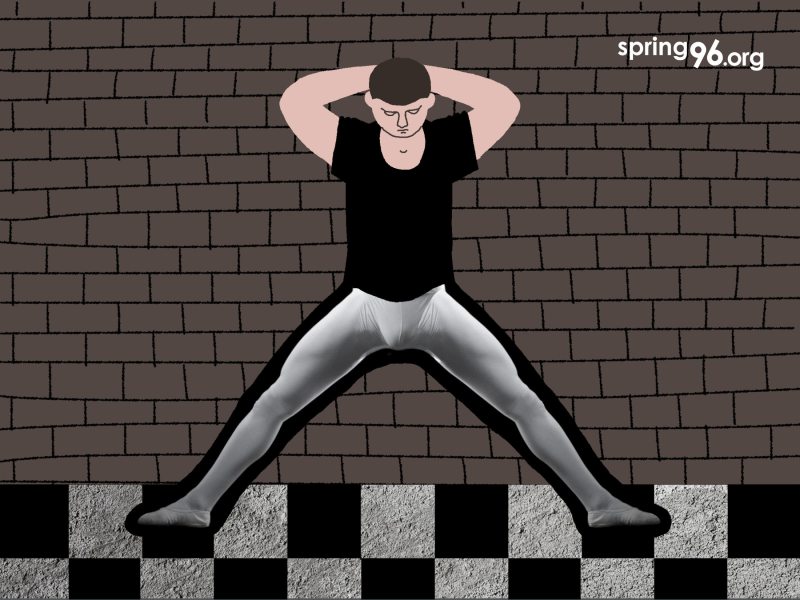
- Illustration by spring96.org
Stress position is a type of torture where the victim is forced to stay in one fixed body position for a long time, which can last from several minutes to several hours or even days.
Body positions can be different: standing on toes, with arms outstretched, twisted and unnatural poses. Also, the prisoner can be fixed in this position with handcuffs, clamps, or ropes.
20-year-old Hanna Morskaya, who was detained five times on administrative cases, was forced to bend her torso and have her head down while standing on her feet for half an hour in May 2022 and was beaten.
Former political prisoner Mikhail, who was detained in the Zeltser case, told Viasna how in 2021, during inspections in the Žodzina prison, prisoners were ordered to stand leaning against the wall with their palms facing themselves with bent wrist joints. Due to the fact that it is very difficult to stand in this position, the prisoners began to lean against the wall with their knuckles.
"The guard noticed this and hit the guy next to me with a baton. He then told the prisoner: 'Why are you standing in a European way? You are in Belarus, stand in a Belarusian way.' That is, leaning on the wrist joints."
Getting a visual impairment in a penal colony. Effects on the sense organs
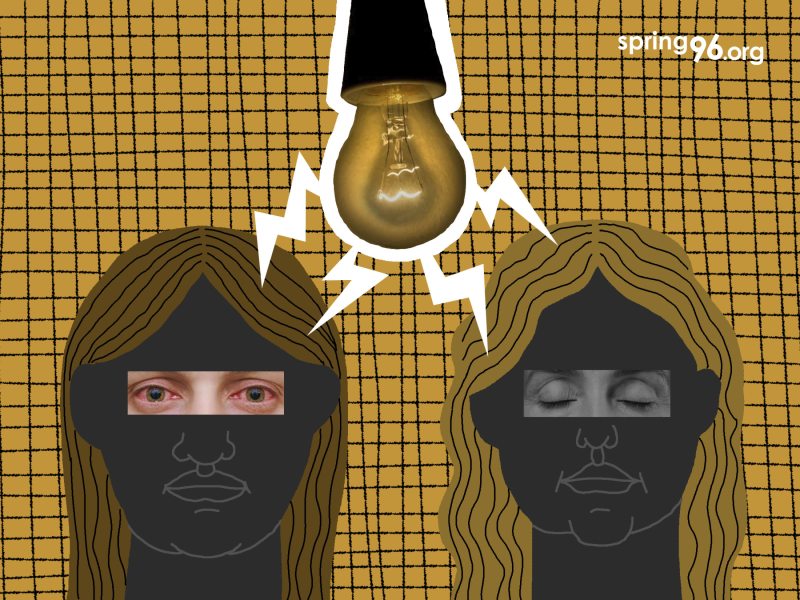
- Illustration by spring96.org
Artificial lighting is on at night in the cells of pre-trial detention centers and temporary detention facilities. It is called "the Moon" in prison slang. Prolonged stay in such conditions worsens both physical and mental health.
Almost all the prisoners who spoke about their experiences in detention testified that the lights were constantly on in their cells.
"At Valadarka prison, day lights were turned off for bedtime and only "the Moon" remained. But at Akrescina there wasn't even this. One day we asked to turn some light off. The guards replied: 'Do you want it to be even darker? Here you go.' And they turned on some kind of lamp that emmited something like X-ray light. It was a crazy light that lacerated eyes." said one of the political prisoners.
The windows of some pre-trial detention cells are covered with iron blinds which cannot be adjusted. They almost do not let in sunlight. This greatly affects the eyesight.
Political prisoner and confidant of Sviatlana Tsikhanouskaya Antanina Kanavalava, who was sentenced to five and a half years in a penal colony, received a visual impairment in custody due to the constant lack of daylight in the cell.
In many prison cells, toilets are not isolated in any way and are located directly in the room where prisoners are held. In addition, many prisoners smoke cigarettes. These circumstances, along with the lack of proper ventilation, create a strong stench in the cell, and the constant lack of fresh air in the cell greatly worsens the health of prisoners.
"They stun you till you are blue." Electroshock weapons
This type of weapon transmits a series of electric current discharges and is designed to temporarily deprive a person of an ability to act. In Belarus, the practice of using a stun gun in police stations to obtain testimony under pressure is widespread.
One of the detainees, Kiryl, who was serving an arrest in the fall of 2023 at Akrescina, spoke about the use of a taser:
"Those who are detained by GUBOPiK come most often badly beaten. Their asses and legs are like eggplants. They stun you till you are blue."
Aliaksei, a prisoner from Akrescina, spoke about a taxi driver whom GUBOPiK employees called to their headquarters for detention:
"He arrived and was immediately taken out of his car and beaten. They sunned him under his fingernails, then poured water on his legs and again stunned him. Naturally, after this, his intestines stopped functioning, and everything poured out. He got dirty all over, and they laughed at him for a long time. They allowed him to take off all his clothes and put a plastic bag on him, tied it to his body with tape, and put a helmet on him. They brought him to the police station and said, 'This is Mario, say hello to him.'"
Sexual abuse and forced undressing
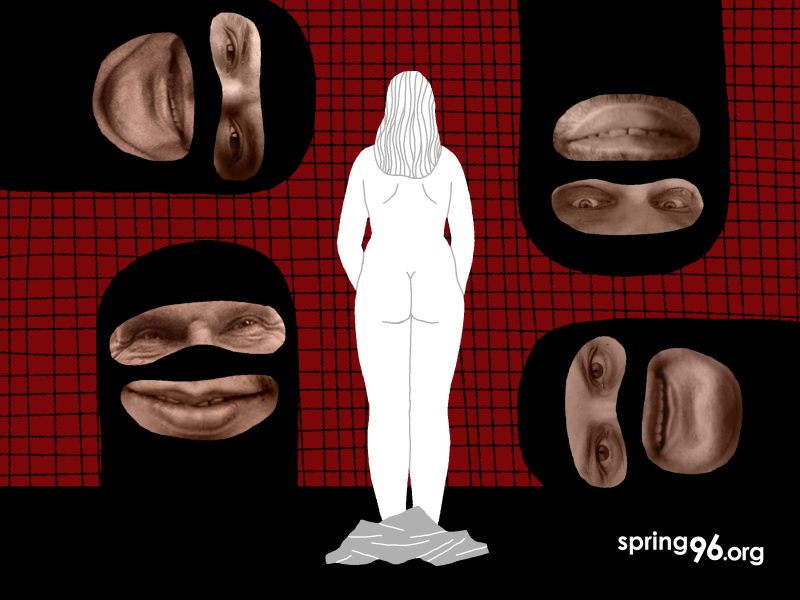
- Illustration by spring96.org
After the mass repression in 2020, victims reported to human rights defenders about repeated threats of sexual violence during detention. And according to the report of the UN High Commissioner for Human Rights Michelle Bachelet, there have been cases of sexual violence in Belarus.
Prisoners also face a full body search. People are forced to completely undress and do several squats.
According to the testimony of former political prisoner Yana Borysovich to journalist Yauheniya Douhaya, her cellmate was forced to undergo an examination by a gynecologist in the presence of a male guard.
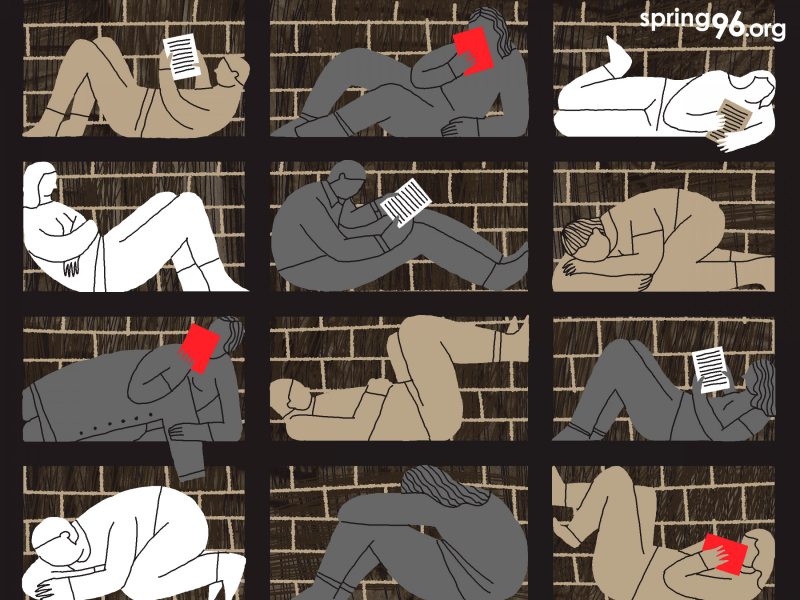
Torture with stress positions, the threat of termination of parental rights: the abuse that Belarusian women face
25 people for eight beds. Overcrowded cells
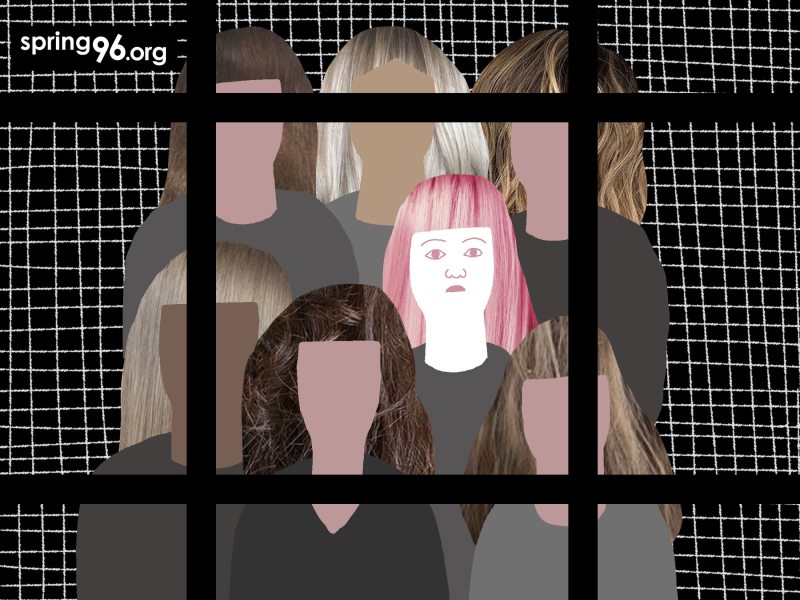
- Illustration by spring96.org
According to DIGNITY - Institute against Torture, there is no generally accepted definition "an overcrowded cell".
The UN Subcommittee on the Prevention of Torture believes that the detention of prisoners in conditions of extreme overcrowding is considered as ill-treatment and even torture if such detention is prolonged and combined with unacceptable physical conditions.
Former political prisoner Mikhail testified about an overcrowded cell in the Žodzina prison. There were 25 people in a 10-bed cell.
Two years in SHIZO. Solitary confinement
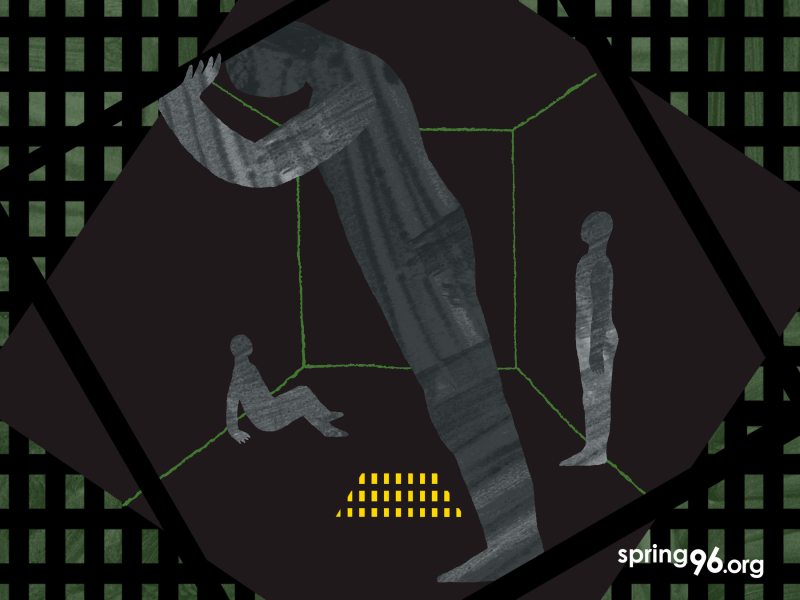
- Illustration by spring96.org
According to Nelson Mandela's rules, solitary confinement is "confinement of prisoners for 22 hours or more a day without meaningful human contact." The UN Standard Minimum Rules for the Treatment of Prisoners prohibit indefinite and prolonged isolation, which is defined as more than 15 consecutive days.
Unfortunately, solitary confinement is a common occurrence in Belarusian prisons. For some of them, the term of detention in SHIZO was extended several times in a row. Thus, former political prisoner Mikhail Zhamchuzhny spent more than two years there during his imprisonment. This torture practice continues and many political prisoners are held in SHIZO for months on end.
A new kind of torture. Incommunicado
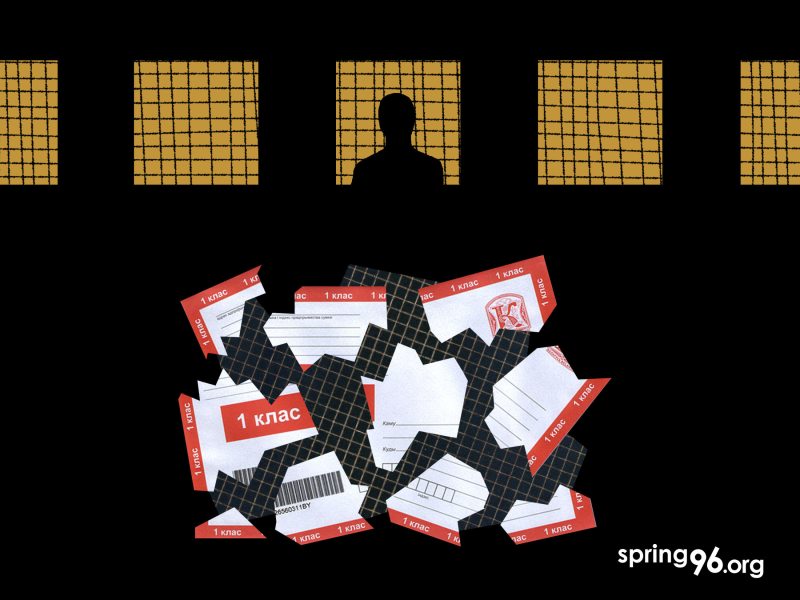
- Illustration by spring96.org
A new type of torture is the incarceration of political prisoners in a state of incommunicado, that is, complete isolation from information. They are kept in SHIZO or PKT (a punishment cell), and they cannot receive and send letters. They cannot talk to their lawyers; they are not allowed phone calls and meetings. Such prisoners are completely isolated from the outside world.
To date, at least six political prisoners are known to be in a state of incommunicado: Siarhei Tsikhanouski, Maryia Kalesnikava, Ihar Losik, Viktar Babaryka, Maksim Znak, Mikalai Statkevich.
Unbearable psychological pain. Death penalty
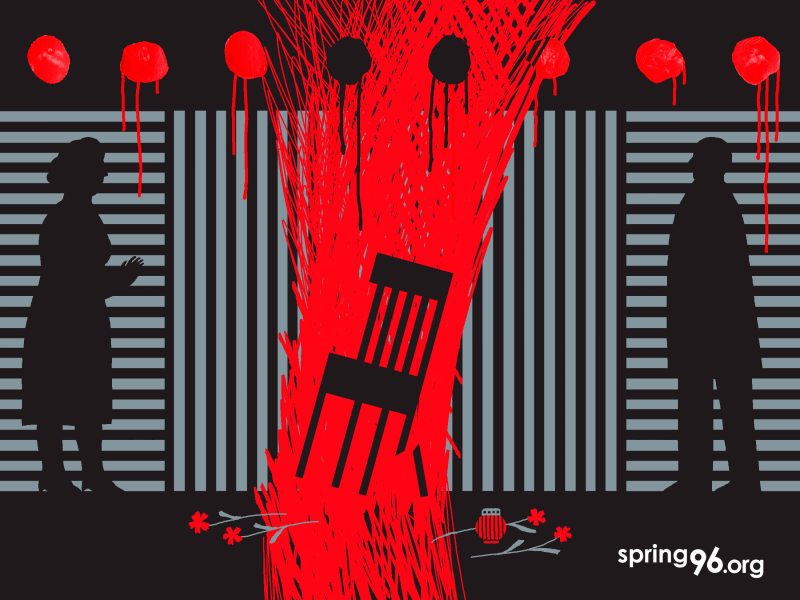
- Illustration by spring96.org
In Belarus, as in 55 more countries, the death penalty is still allowed. In our country, people are sentenced to death by firing squad. A total of 144 countries in the world have refused to kill a person as punishment for a crime.
The term "death row phenomenon" is used to describe being on death row. There, a person is held in solitary confinement for a long time, awaiting punishment. Those sentenced to death have much more frequent psychological disorders. According to DIGNITY research, they suffer from unbearable psychological pain. Death row inmates have a higher risk of suicide.
Some researchers talk about the "death row syndrome", accompanied by an extreme degree of anxiety, dissociation, and psychosis. In addition, the death penalty itself can bring severe physical pain and suffering to a person.
In Slutsk, on October 19, 2023, Aliaksandra Taratuta was sentenced to death by firing squad; he was found guilty of murdering his three-year-old child.
"They could tear down the curtains off the shower stall." Other examples of ill-treatment
Former political prisoner journalist Volha Klaskouskaya, who spent 791 days in imprisonment, told Viasna how there was only one shower per 100 people in the Homieĺ colony and how difficult it was to get there, as well as about the psychological pressure on political prisoners:
"After working in the industrial zone, about a hundred sweaty and dirty women come from the factory. You literally have 25 minutes to get in line and wash at least some parts of your body. It's a nightmare. ... But at any moment, the heads of the detachments could come and tear down the curtains off the shower stall. And the person is naked and has to explain why they use the shower."
In addition to the mentioned types of torture, incarcerated Belarusians face numerous examples of ill-treatment. During detention, the humiliating practice of "penitential" videos is actively used. During imprisonement, prisoners are kept in extreme cold for a long time, and they get sick because of it; they are poorly fed. They are kept without a toilet and bed linen. The treatment of prisoners is becoming increasingly cruel and inhumane. It often very similar to torture.
Viasna Human Rights Center continues to collect and document the facts of torture in Belarus
If you have suffered from torture by the security forces or have faced inhuman and cruel treatment in a pre-trial detention center or violation of human rights, please write to: Telegram: @ViasnaDOC. Email: viasnadoc@spring96.org. You can also tell your story to the journalists of Viasna: @Spring96info.

















